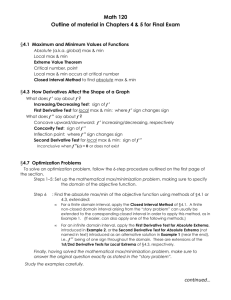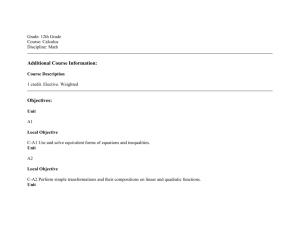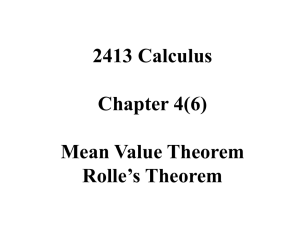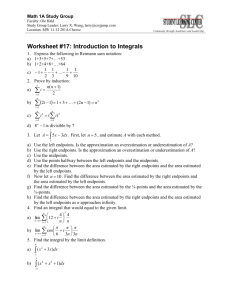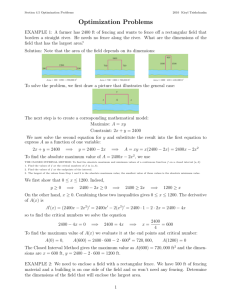Steps for Optimization Problems 1. Draw and label a picture
advertisement
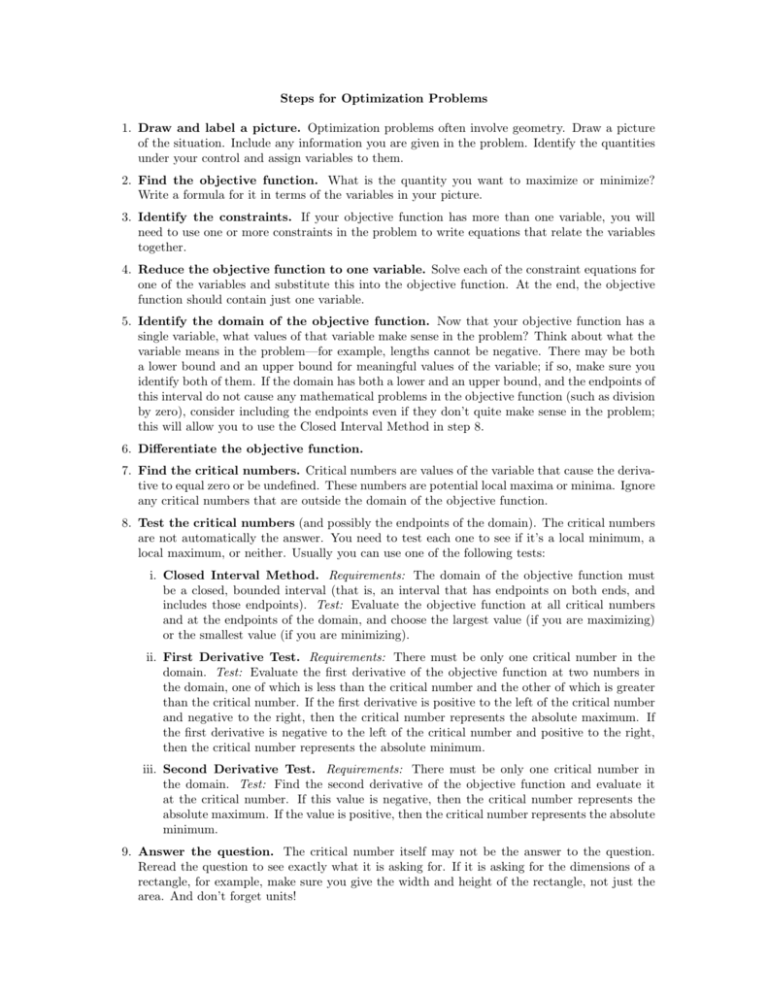
Steps for Optimization Problems 1. Draw and label a picture. Optimization problems often involve geometry. Draw a picture of the situation. Include any information you are given in the problem. Identify the quantities under your control and assign variables to them. 2. Find the objective function. What is the quantity you want to maximize or minimize? Write a formula for it in terms of the variables in your picture. 3. Identify the constraints. If your objective function has more than one variable, you will need to use one or more constraints in the problem to write equations that relate the variables together. 4. Reduce the objective function to one variable. Solve each of the constraint equations for one of the variables and substitute this into the objective function. At the end, the objective function should contain just one variable. 5. Identify the domain of the objective function. Now that your objective function has a single variable, what values of that variable make sense in the problem? Think about what the variable means in the problem—for example, lengths cannot be negative. There may be both a lower bound and an upper bound for meaningful values of the variable; if so, make sure you identify both of them. If the domain has both a lower and an upper bound, and the endpoints of this interval do not cause any mathematical problems in the objective function (such as division by zero), consider including the endpoints even if they don’t quite make sense in the problem; this will allow you to use the Closed Interval Method in step 8. 6. Differentiate the objective function. 7. Find the critical numbers. Critical numbers are values of the variable that cause the derivative to equal zero or be undefined. These numbers are potential local maxima or minima. Ignore any critical numbers that are outside the domain of the objective function. 8. Test the critical numbers (and possibly the endpoints of the domain). The critical numbers are not automatically the answer. You need to test each one to see if it’s a local minimum, a local maximum, or neither. Usually you can use one of the following tests: i. Closed Interval Method. Requirements: The domain of the objective function must be a closed, bounded interval (that is, an interval that has endpoints on both ends, and includes those endpoints). Test: Evaluate the objective function at all critical numbers and at the endpoints of the domain, and choose the largest value (if you are maximizing) or the smallest value (if you are minimizing). ii. First Derivative Test. Requirements: There must be only one critical number in the domain. Test: Evaluate the first derivative of the objective function at two numbers in the domain, one of which is less than the critical number and the other of which is greater than the critical number. If the first derivative is positive to the left of the critical number and negative to the right, then the critical number represents the absolute maximum. If the first derivative is negative to the left of the critical number and positive to the right, then the critical number represents the absolute minimum. iii. Second Derivative Test. Requirements: There must be only one critical number in the domain. Test: Find the second derivative of the objective function and evaluate it at the critical number. If this value is negative, then the critical number represents the absolute maximum. If the value is positive, then the critical number represents the absolute minimum. 9. Answer the question. The critical number itself may not be the answer to the question. Reread the question to see exactly what it is asking for. If it is asking for the dimensions of a rectangle, for example, make sure you give the width and height of the rectangle, not just the area. And don’t forget units!

